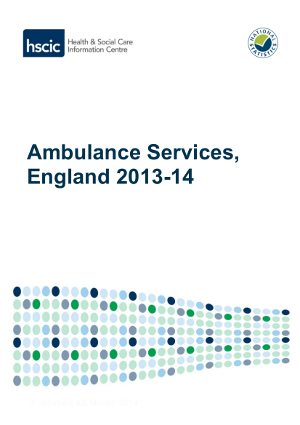A statement from the AACE: “The Association of Ambulance Chief Executives (AACE) welcomes any initiative that helps the public to better understand how their local NHS ambulance services are performing against national demand.
 While today’s report (31 July 2014) issued by the Health and Social Care Information Centre (HSCIC) on ambulance service demand and performance during 2013-14 is a positive move towards greater transparency in this area, unfortunately AACE believes that the way in which some of the top line data is interpreted in the report is unclear, and due to a number of factors could be misinterpreted by the public.
While today’s report (31 July 2014) issued by the Health and Social Care Information Centre (HSCIC) on ambulance service demand and performance during 2013-14 is a positive move towards greater transparency in this area, unfortunately AACE believes that the way in which some of the top line data is interpreted in the report is unclear, and due to a number of factors could be misinterpreted by the public.
The report suggests that demand for ambulance services has fallen in 2013-14, but this appears to run contrary to the national experience of demand by ambulance services, which is that it continues to rise.
The report notes that there have been changes in the way the data has been collected for 2013-14 as opposed to previous years and it could be that this is responsible for the potential anomaly in the data.
One of the most important items in the report to note is that the decrease in direct 999 calls highlighted by the report is more than offset by a dramatic increase in activity coming via the increased use of the 111 number.
This is a huge increase of around 5000% (from 13,618 in 2010-11 to 756,768 in 2013-14) which shows that the successful rollout of 111 by ambulance services has led a significant proportion of the public to call 111 instead of 999, and that calls to the ambulance service are being received via a different route. This may explain why the total 999 figure decreased from 2012-13 to 2013-14 and appears to be a reduction in demand.
However, a proportion of those calls made to NHS 111 still end up in a request for an ambulance – something that doesn’t appear to be clearly highlighted in the HSCIC report.
The number of people calling 111 and being transferred to 999 was 151,014 in 2012-13 and was 756,768 in 2013. This increase in NHS111 calls transferred to 999 is far greater than the 71,000 reduction in 999 calls reported by the HSCIC figures from 2012-13 to 2013-14. A substantial proportion of calls to 111 in 2013-14 were transferred to the ambulance service – 8.6%.
The ambulance service’s own analysis of total activity (calls receiving telephone advice or a face to face response) using the original KA34 return data, indicated a 10.7% increase in total activity from 2009-10 to 2012-13.
Similarly the ambulance service’s own analysis of incidents (calls receiving face to face response) using the KA34 return data indicated an 18.5% increase in incidents from 2009-10 to 2012-13.
The AACE will offer its assistance to the HSCIC to clarify certain aspects of data collation and better understand its interpretation.
To further aid transparency over ambulance service demand and consequent performance, the AACE has commissioned a comprehensive academic review of ambulance demand which we expect to publish in the autumn.”
